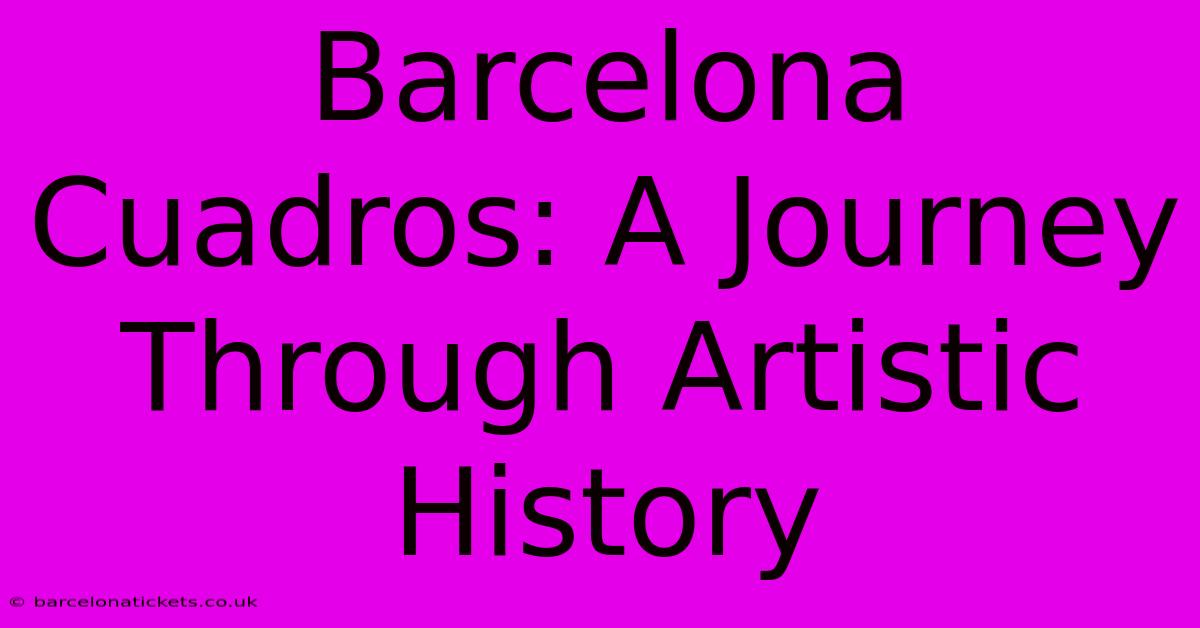Barcelona Cuadros: A Journey Through Artistic History

Table of Contents
Barcelona Cuadros: A Journey Through Artistic History
Barcelona, a city pulsating with life and brimming with architectural marvels, also boasts a rich tapestry of artistic heritage. Exploring its "cuadros" – meaning "pictures" or "paintings" in Spanish – offers a captivating journey through centuries of artistic innovation and cultural evolution. From the Gothic Quarter's hidden gems to the modern masterpieces gracing contemporary galleries, Barcelona's artistic legacy is interwoven into the very fabric of the city.
Delving into Barcelona's Artistic Past: A Timeline of Cuadros
Barcelona's artistic story is a long and winding one, marked by distinct periods and styles. Let's explore some key eras:
The Medieval & Gothic Period (14th - 15th Centuries):
This era laid the foundations for Barcelona's artistic identity. Religious art dominated, with altarpieces and frescoes adorning churches and monasteries. While many pieces were lost or destroyed over time, remnants of this period can still be found in museums and private collections, offering glimpses into the spiritual and societal values of the time. These early cuadros often featured symbolic imagery and a distinct medieval aesthetic.
The Renaissance & Baroque Periods (16th - 18th Centuries):
The influence of Italian Renaissance and later Baroque styles gradually permeated Barcelona's artistic landscape. Artists began to explore realistic depictions of the human form and natural world, moving away from the purely symbolic representations of the medieval era. This period witnessed a rise in portraiture and still life, reflecting a growing interest in individual expression and the beauty of everyday life. Look for works showcasing the characteristic richness of color and dramatic use of light and shadow typical of the Baroque style.
The Modernista Movement (Late 19th - Early 20th Centuries):
This period is arguably the most iconic in Barcelona's artistic history. Antoni Gaudí, the city's most celebrated architect, spearheaded the Modernista movement, leaving an indelible mark on the city's architecture and art. While primarily known for his buildings, Gaudí's artistic vision extended to various art forms, influencing the style of many contemporary painters and sculptors. This era saw a flourishing of decorative arts, vibrant colors, and intricate details, reflecting a strong sense of Catalan identity and pride. Exploring the cuadros of this period reveals the unique stylistic elements that defined Modernisme.
20th and 21st Century Art:
Barcelona's artistic dynamism continues to this day. The city boasts a thriving contemporary art scene, with numerous galleries showcasing the works of both established and emerging artists. Styles range from abstract expressionism to conceptual art, reflecting the globalized and diverse nature of modern society. This vibrant contemporary art scene makes Barcelona a compelling destination for art enthusiasts seeking to discover the latest trends and innovations.
Where to Find Barcelona's Cuadros: Museums and Galleries
Discovering Barcelona's cuadros requires exploring its diverse cultural institutions:
-
Museu Nacional d'Art de Catalunya (MNAC): This museum houses an extensive collection of Catalan art, spanning from the Romanesque period to the 20th century. It's an invaluable resource for understanding the evolution of Catalan artistic styles.
-
Picasso Museum: Dedicated to the early works of Pablo Picasso, who spent his formative years in Barcelona, this museum offers a crucial insight into the artist's development and his connection to the city.
-
Fundació Joan Miró: This foundation showcases a vast collection of works by Joan Miró, one of the most important figures in 20th-century Surrealism. Its stunning building and beautiful gardens add to the artistic experience.
-
MACBA (Barcelona Museum of Contemporary Art): This museum focuses on contemporary art, showcasing works from the mid-20th century to the present day, reflecting the city's ongoing artistic innovation.
Beyond these major museums, numerous smaller galleries scattered throughout the city offer opportunities to discover emerging artists and hidden gems. Exploring the El Raval and Gothic Quarter neighborhoods is particularly rewarding for art lovers.
Beyond the Museums: Street Art and Artistic Installations
Barcelona's artistic expression extends beyond museum walls. The city's vibrant street art scene adds another layer to its artistic landscape. Exploring different neighborhoods will reveal murals, graffiti, and installations that reflect the city's multiculturalism and creative spirit.
Barcelona Cuadros: A Lasting Impression
A journey through Barcelona's cuadros is far more than just a sightseeing adventure; it's an immersive experience that reveals the city's soul, its history, and its ever-evolving cultural identity. From the grandeur of the past to the vibrant energy of the present, Barcelona's artistic heritage offers a captivating story for all who care to explore it.

Thank you for visiting our website wich cover about Barcelona Cuadros: A Journey Through Artistic History. We hope the information provided has been useful to you. Feel free to contact us if you have any questions or need further assistance. See you next time and dont miss to bookmark.
Featured Posts
-
Will Diaz Join Barcelonas Winning Streak
Apr 05, 2025
-
Discover Barcelonas Hidden Beach Club Gems Part 1
Apr 05, 2025
-
Unique Catering Bodas Barcelona Beyond Traditional Fare
Apr 05, 2025
-
Barcelona Apartment Time To Sell
Apr 05, 2025
-
Barcelona 2012 Black Jersey A Gift For The True Fan
Apr 05, 2025
